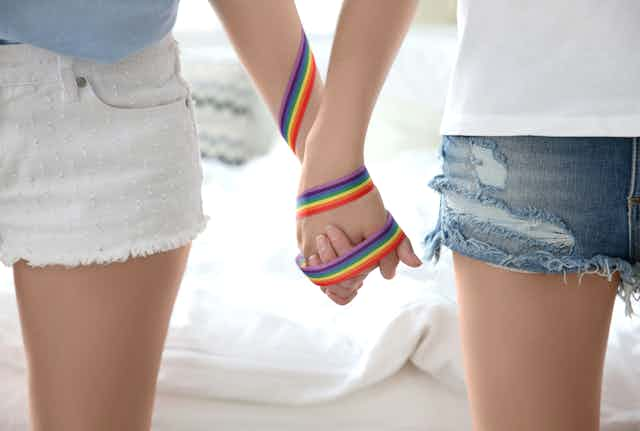The results of the same-sex marriage postal survey were clear: Australia voted in favour of equality. The marriage equality bill has passed, and the mandate to deliver inclusive sexuality education in schools is more pressing than ever. LGBTQi+-inclusive sexuality education should embrace diversity in the classroom, the staff-room and in whole-of-school policies.
LGBTQi+-inclusive sexuality education reduces negative stereotypes and biases, creating a safer school environment for LGBTQi+ students. When schools adopt inclusive policies across all school curricula (not just sexuality education), all students feel safer.
How many young Australians identify as LGBTQi+?
The acronym stands for lesbian, gay, bisexual, transgender, queer, intersex and more. Adolescents might not want a specific label, or might not feel safe disclosing their identities or attractions. So, we’re talking about a varied group, and about a lot of our country’s young people.
Around 10% of Australian secondary students are same-sex attracted. A smaller percentage will identify as gay, lesbian or bisexual.
Gender identity is how an individual conceives of themself as male, female, both or neither. Usually, this develops in the pre-school years.
Read more: When do children develop their gender identity?
We don’t have good Australian data yet, but a national survey in New Zealand found 1.2% of secondary students identified as transgender.
About 1.7% of children are intersex, which means they are born with physical sex characteristics that don’t fit medical and social norms for female or male bodies. A recent survey suggested intersex adults are more likely to be non-heterosexual.
What does LGBTQi+-inclusive sexuality education look like?
The United Nations Educational, Scientific and Cultural Organisation defines “comprehensive sexuality education” as being age-appropriate, culturally relevant, scientifically accurate and non-judgemental and acknowledges diversity. This means it includes information about, and resources relevant to, sexuality and gender diverse students.
Comprehensive sexuality education also addresses values, relationships, consent and pleasure, and provides information about access to relevant health services. It has a positive impact on knowledge, decision-making skills, communication with parents or carers, and use of protection against pregnancy and sexually transmitted infections (STIs) for sexually active students.
Read more: Rational, modern sex education is a must for all Aussie kids
Canada and some states in the USA already mandate LGBTQi+-inclusive sexuality education.
Australia now has a national curriculum on Health and Physical Education that generally adopts these principles.
The problems are insufficient time, training, resources and policy support. This makes it difficult for many of our teachers to cover the range of topics that constitute comprehensive sexuality education for all students. A massive 44% of same-sex attracted Australian young people rated their sex education at school as not useful at all.
What do young people want to know?
A recent survey of 2,000 students in Victoria and South Australia found young people want less repetition of biology and more information about gender diversity, violence in relationships, sexual pleasure, intimacy and love.
I was the medical writer for Dolly Doctor for 23 years before the magazine closed. I found adolescents’ concerns about sex were mostly about changing bodies, feelings of arousal and attraction (including same-sex attraction), and relationships. Adolescents who were thinking about having sex wanted information about consent, communication, how to negotiate various types of sexual experiences, and pleasure.

Research among LGBTQi+ young people found tthey would like specific content about STI patterns in non-heterosexual relationships, how to prevent STIs, information about anatomy and diversity, more information in general about relationships, and where to find relevant resources and services.
Basically, when it comes to sexuality, heterosexual and LGBTQi+ young people are curious about the same things. They want to know about bodies and how they work, emotions (love, pleasure, desire and intimacy), relationships and consent, safety, STIs and how risk varies, contraception, and where to go for help with these things. More than this, they have the right to know.
What should happen now?
The school environment should promote understanding of and respect for sexuality and gender diversity. Policies and programs to address homophobic and transphobic abuse and support the professional development of school staff, are crucial to inclusive sexuality education.
Read more: Making schools safer and more welcoming for LGBTQI students
Involving parents in information sessions within schools and listening to their views helps alleviate concerns.
A recent study of 342 Australian parents found the majority support sexuality education in primary school, including information about same-sex attraction. This was because it can be difficult for them to discuss at home, but they believe it’s important for children to learn about.
Respectful classrooms are great places for young people to learn about sexuality and where to go for relevant information. Much better than the sorts of places the internet could take them if they Google. Leaving young people to figure it out themselves because we’re nervous or uncomfortable could result in ill-informed decision-making. It also withholds knowledge that is their right to have. Sexuality education should be empowering and provide young people with the skills to live sexually healthy lives.
Marriage equality has been a long time coming. Let’s treat our sexuality and gender diverse young people with the respect they deserve.

